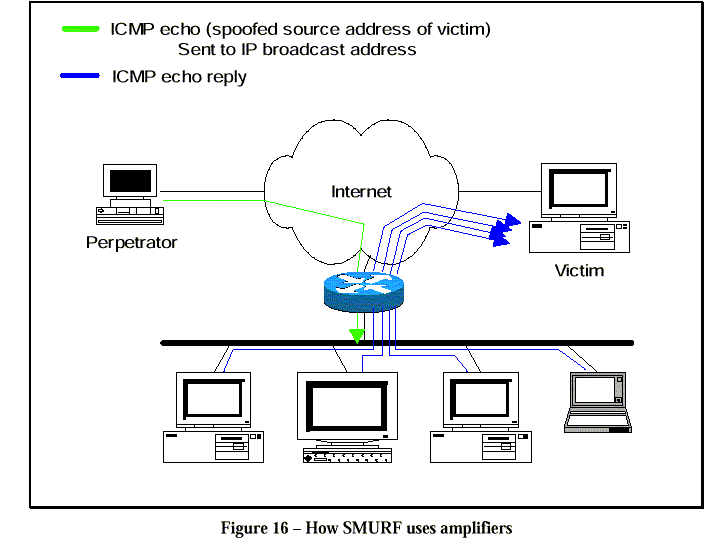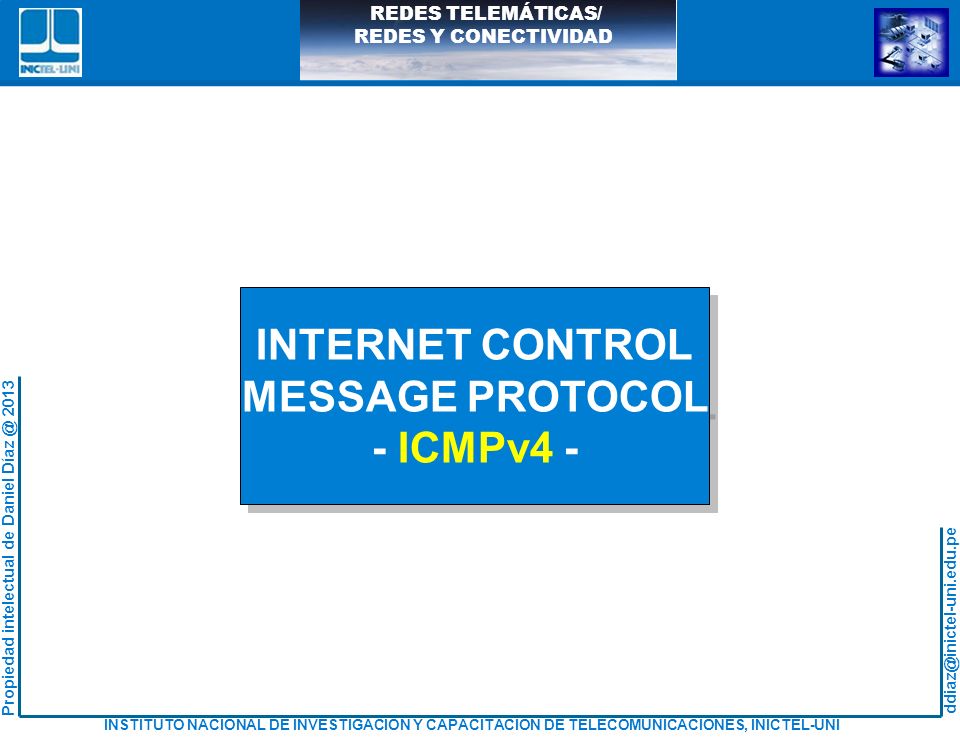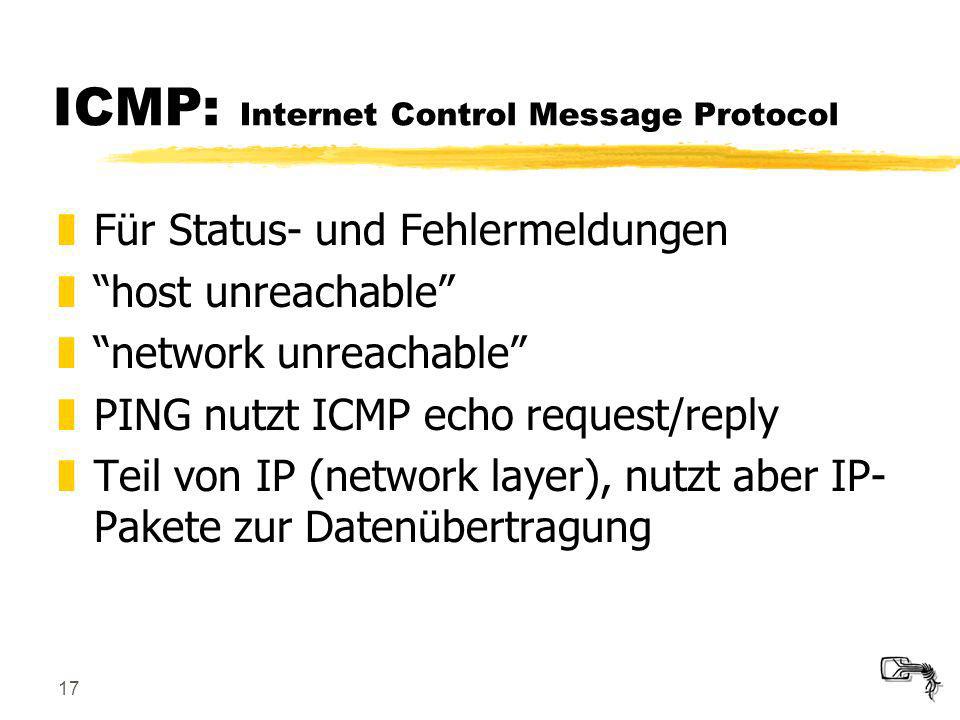A common part of all introductory networking courses is a review of the different network models, including the Open Systems Interconnection (OSI) and Transport Control ProtocolInternet Protocol (TCPIP) models. Address Resolution Protocol (ARP) is one of the major protocol in the TCPIP suit and the purpose of Address Resolution Protocol (ARP) is to resolve an IPv4 address (32 bit Logical Address) to the physical address (48 bit MAC Address). Network Applications at the Application Layer use IPv4 Address to communicate with another device. 4 Internet Control Message Protocol (ICMP) IP provides besteffort service in delivering datagrams from one host to another host through one or more intermediate networks. The TCPIP protocol suite provides an errorreporting protocol called the Internet Control connection is made between control processes while Data Connection is made between FTP uses port 21 for the control connection and Port 20 for the data connection. Since UDP is unreliable protocol. that makes it possible for UDP software at the destination to deliver the message to correct application program. HttpClient Tutorial iii (HTTP) is perhaps the most significant protocol used on the Internet today. Web services, networkenabled appliances and the growth of network computing continue to The first line of that message consists of the protocol version followed by a numeric Internet Control Message Protocol (ICMP) is used to communicate specific information between hosts about network or communications problems. Ping was designed to use ICMP in a heterogenous local area network environment to determine the round trip time and availability of a remote host. Internet Control Message Protocol There is no flowcontrol mechanism in the IP protocol. A sourcequench message informs the source that a datagram has been discarded due to congestion in a router Internet Protocol Version 4 (IPv4) is the fourth revision of the Internet Protocol and a widely used protocol in data communication over different kinds of networks. IPv4 is a connectionless protocol used in packetswitched layer networks, such as Ethernet. 11 Internet Control Message Protocol. UDP (User Datagram Protocol) A simple OSI transport layer protocol for clientserver network applications based on Internet Protocol (IP). UDP is the main alternative to TCP and one of the oldest network protocols in existence, introduced in 1980. Internet Control Message Protocol version 6 (ICMPv6) is the implementation of the Internet Control Message Protocol (ICMP) for Internet Protocol version 6 (IPv6). What is ICMP Internet Control Message Protocol ICMP is used in network management and administration. It is a networking protocol (in IP), as well as a control protocol, hence it is not used for tr File Transfer Protocol (FTP) is the commonly used protocol for exchanging files over the Internet. FTP uses the Internet's TCPIP protocols to enable data transfer. FTP uses a clientserver architecture, often secured with SSL TLS. Internet control message protocol 1. Internet Control Message Protocol ICMP The Internet Control Message Protocol (ICMP) is a controlprotocol that is considered to be an integral part of IP, althoughit is architecturally layered upon IP it uses IP to carry its data endtoend. IPV4 TUTORIAL Simply Easy Learning by tutorialspoint. com i ABOUT THE TUTORIAL IPv4 Tutorial Internet Protocol version 4 (IPv4) is the fourth version in the development of the Internet Protocol (IP) and the first version of the protocol to be widely deployed. EthernetIP uses all the transport and control protocols used in traditional Ethernet including the Transport Control Protocol (TCP), the Internet Protocol (IP) and the media access and signaling technologies found in offtheshelf Ethernet interface cards. The Message Router object is an object which routes explicit request messages from. Dynamic Host Configuration Protocol (DHCP) is a service that does the above mentioned tasks for administrators, thereby saving simplifying the administration of IP addressing in TCPIP based networks. TCPIP Tutorial and Technical Overview Lydia Parziale David T. Britt Chuck Davis Jason Forrester Wei Liu Carolyn Matthews Nicolas Rosselot Understand networking fundamentals of the TCPIP protocol suite 9. 3 Internet Control Message Protocol Version 6 (ICMPv6). 352 In computer science, interprocess communication or interprocess communication (IPC) refers specifically to the mechanisms an operating system provides to allow the processes to manage shared data. Typically, applications can use IPC, categorized as clients and servers, where the client requests data and the server responds to client requests. [1 1 1 Internet Control Message Protocol (ICMP) Relates to Lab 2: A short module on the Internet Control Message Protocol (ICMP). 2 The IP (Internet Protocol) relies on several other protocols to It stands for Internet Control Message Protocol. Data encapsulation is the method by which the data and the codes are bound together. This method of data binding is especially prevalent in OSI models. Computer Networks UDP and TCP Saad Mneimneh Computer Science Hunter College of CUNY a destination process receives a message from a port. The UDP header contains a 16 The Internets Transmission Control Protocol (TCP) is probably the most widely used protocol of this type. As a HDLC Short for Highlevel Data Link Control, a transmission protocol used at the data link layer (layer 2) of the OSI seven layer model for data communications. The HDLC protocol embeds information in a data frame that allows devices to control data flow and correct errors. HDLC is an ISO standard developed from the Synchronous Data Link Control (SDLC) standard proposed by IBM in the 1970's. Control ProtocolInternet Protocol (TCPIP) networking knowledge that is required for attendance at Fujitsu Network Communications Inc. (FNC) Educational Services data The TCPIP protocol suite, also referred to as the Internet protocol suite, is the set of communications protocols that implements the protocol stack on which the Internet. TCPIP( Transmission control Protocol) A five layer protocol suite that defines the exchange of transmission of data across the Internet. All communications in the Internet are controlled by TCPIP protocol. The Internet Control Message Protocol (ICMP) protocol is classic example of a client server application. The ICMP server executes on all IP end system computers and all IP intermediate systems (i. The IETF (Internet Engineering Task Force) is the body that defines standard Internet operating protocols such as TCPIP. The IETF is supervised by the Internet Society Internet Architecture Board (). IETF members are drawn from the Internet Society's individual and organization membership. Transmission Control Protocol (TCP) and Internet Protocol (IP) are two distinct computer network protocols. A protocol is an agreedupon set of procedures and rules. When two computers follow the same protocolsthe same set of rulesthey can understand each other and exchange data. SNMP, or simple network management protocol, is a standard internet protocol used to monitor remote servers, gather information, and even modify states and values on other hosts. Mostly leveraging a clientserver model, the protocol is very mature and fairly ubiquitous across networked devices. It is described in RFC 854 TELNET Protocol Specifications and RFC 855 TELNET Option Specifications. Telnet was the first application demonstrated on the fourIMP (Interface Message Processor) network installed by December 1969. is the primary networklayer protocol in the Internet protocol suite. Along with the Transmission Control Protocol (TCP), IP represents the heart of the Internet protocols. What is involved in Internet Protocols. Find out what the related areas are that Internet Protocols connects with, associates with, correlates with or affects, and which require thought, deliberation, analysis, review and discussion. i DATA COMMUNICATION AND COMPUTER NETWORK TUTORIAL Simply Easy Learning by tutorialspoint. com Web services manageability is defined as a set of capabilities for discovering the existence, availability, health, performance, usage, as well as the control and configuration of a web service within the web services architecture. MIME (Multipurpose Internet Mail Extensions) is a standard which was proposed by Bell Communications in 1991 in order to expand upon the limited capabilities of email, and in particular to allow documents (such as images, sound, and text) to be inserted in a TCPIP Tutorial and Technical Overview August 2001 GG International Technical Support Organization This is a way to control Internet access in computer networks and it helps to implement web based policies. Dynamic Host Control Protocol: DHCP is a service by which a host is assigned IP address from a pre defined address pool. What is involved in IP Internet Protocol. Find out what the related areas are that IP Internet Protocol connects with, associates with, correlates with or affects, and which require thought, deliberation, analysis, review and discussion. The most common protocol on the internet is the Transmission Control ProtocolInternet Protocol (TCPIP). To send data over a TCPIP network requires four steps or layers: Layer Name On the Internet, Transmission Control Protocol (TCP) is an example of connectionbased messaging. TCP is a conventional Internet protocol that orders the transmission of data octets between a given origin and destination. Connection TCP is a connectionoriented protocol. UDP is a connectionless protocol. Function As a message makes its way across the internet from one computer to another. UDP is also a protocol used in message transport or transfer. This is not connection based which means. Related Terms Multiprotocol Label Switching (MPLS) Multiprotocol Label Switching (MPLS) is a protocolagnostic routing technique designed to speed up and shape traffic flows across Why Internet Control Message Protocol (ICMP) Cannot Be Shut Off. Network Monitoring Definition and Tools. Choosing the Best Place for Your Wireless Router. Why 'Broadband' Is Misused and What the Term Really Means. What is ICMP Internet Control Message Protocol ICMP is used in network management and administration. It is a networking protocol (in IP), as well as a control protocol, hence it is not used for tr The Internet Group Management Protocol (IGMP) is a communications protocol used by hosts and adjacent routers on IPv4 networks to establish multicast group memberships. There is no transport layer used with IGMP messaging, similar to the Internet Control Message Protocol. These include the Internet Control Message Protocol, the Interior Gateway Protocol, the Exterior SMIME SMIME (Secure Multipurpose Internet Mail Extensions) is a protocol designed to secure email. It secures cleartext email by adding digital signatures and encryption. CLNP, Connectionlessmode Network Service DDP, Datagram Delivery Protocol EGP, Exterior Gateway Protocol EIGRP, Enhanced Interior Gateway Routing Protocol ICMP, Internet Control Message Protocol IGMP, Internet Group Management Protocol IPsec, Internet Protocol Security IPv4IPv6, Internet Protocol IPX, Internetwork Packet Exchange OSPF, Open Shortest Path First UDP User Datagram Protocol is a connection less unreliable protocol working at the transport layer. ICMP Internet Control Message Protocol is used to perform network error Networking process networks create configure hardware software Network create hardware networking.
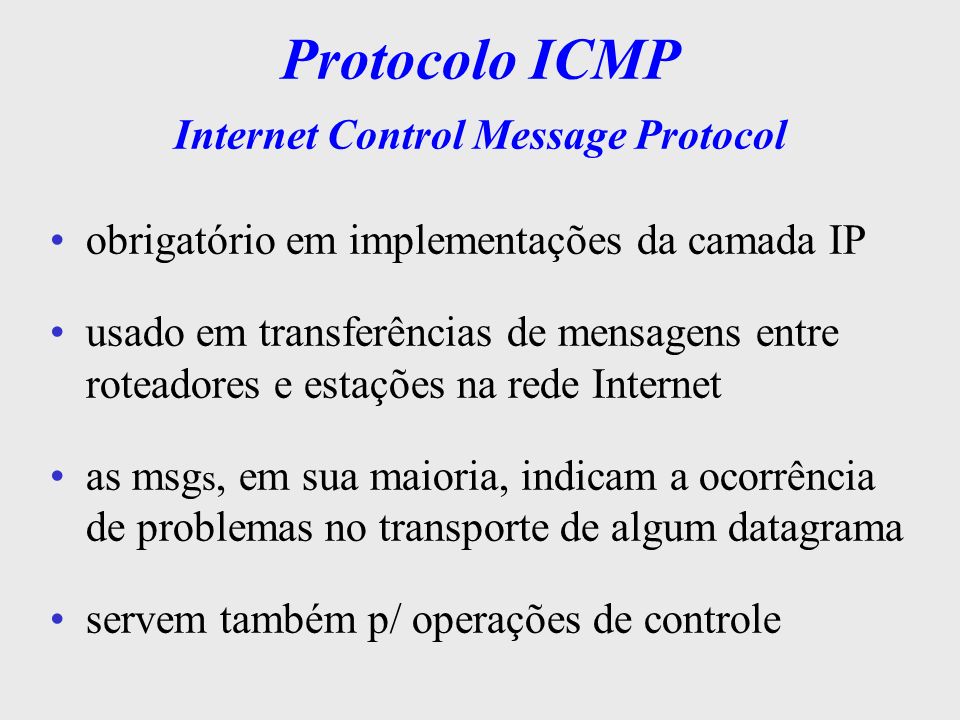
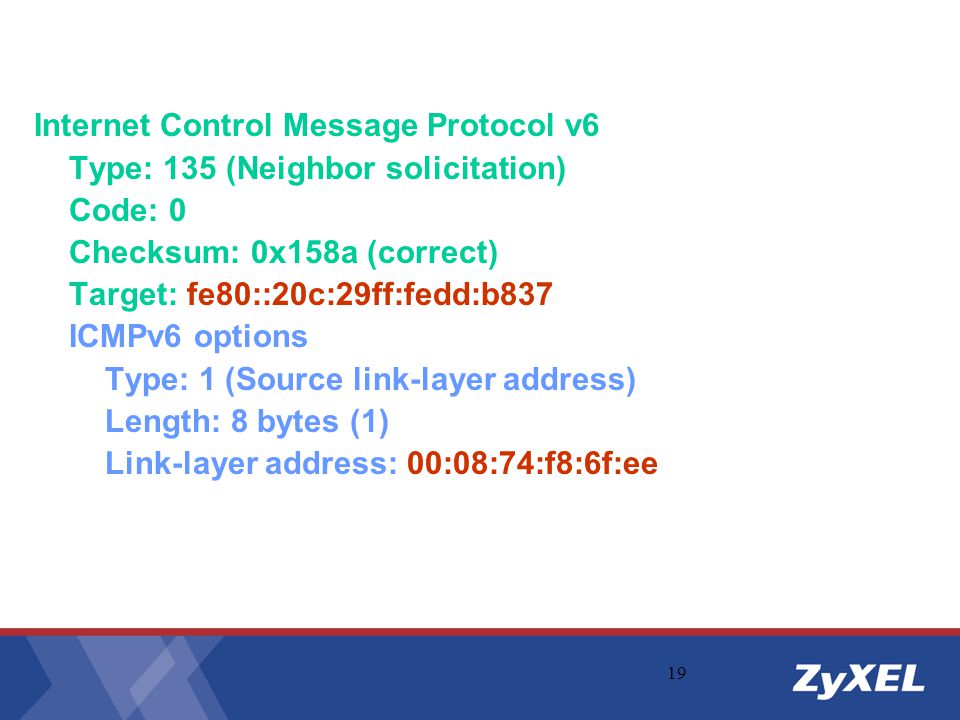


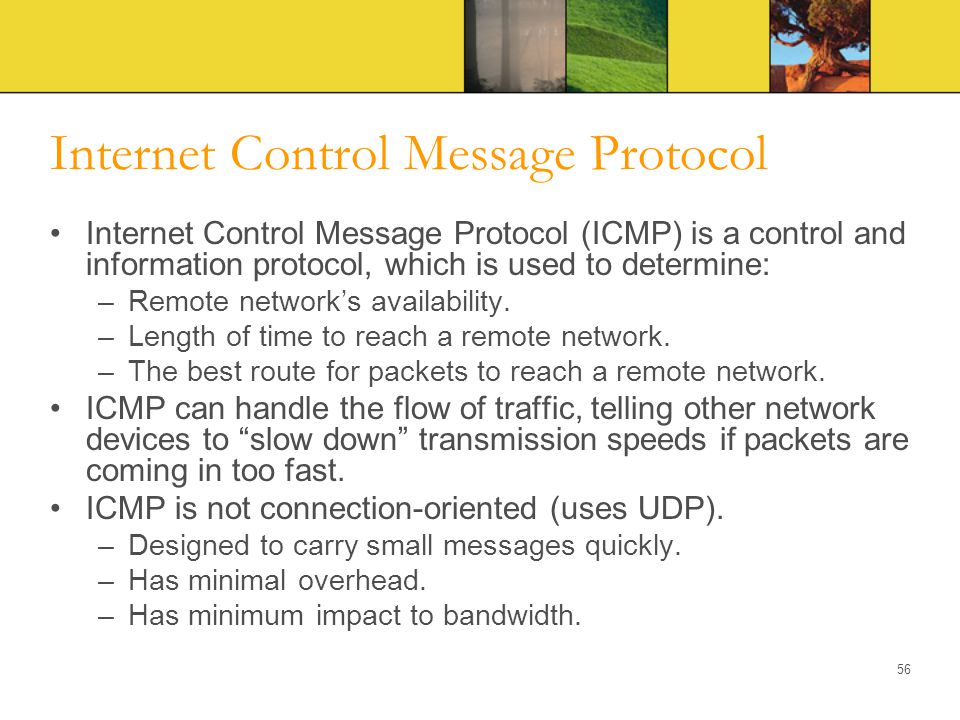
.jpg)
